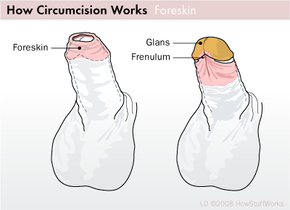The Foreskin
The foreskin (also known as the prepuce) is a portion of skin on the penis that covers and protects the tip of the penis, also known as the glans. It can be a tough world for a glans -- there's abrasion from undergarments, cold winter weather and dry air. It's good to have a protection policy in place, and the foreskin provides that protection for the glans.
When males are born, the skin on the penis extends over the glans, protecting it on day one from the wear and tear it will undergo in that lifetime. The foreskin can account for one-third to nearly one-half of total penile skin.
Advertisement
While its outer appearance is the same as any other skin on the penis, the foreskin is home to many nerve bundles and blood cells, and its inner surface is similar to the inside of your mouth, helping the glans stay naturally lubricated. Between the outer layer and the moist inner layer is a ridged band with additional nerve endings. A piece of tissue called the frenulum connects the foreskin to the glans. It looks (and functions somewhat) like the connective tissue beneath your tongue. When the penis is flaccid, the frenulum tightens to narrow the opening of the foreskin.
Those nerves packed into the foreskin provide additional stimulation during sexual activities. Its lubricating function also assists in sexual intercourse. Additionally, the frenulum (which is removed in some circumcisions) provides stimulation. Since the glans is kept moist and soft by the foreskin, it too is more sensitive to touch.
Some men may have foreskins that cover nearly the entire glans, while others may only have partially covered glans. Some men are naturally circumcised -- either they're born with very little foreskin in the first place or have foreskins that fully retract beneath the glans around puberty.
Though they serve a protective purpose, foreskins can cause problems. Since the foreskin keeps the glans lubricated, it must also be kept very clean to prevent bacteria buildup. When regular hygiene is not maintained, a white cheesy discharge called smegma may accumulate beneath the foreskin. Continued poor hygiene can lead to infections and urinary tract infections.
If a foreskin is too tight and won't properly retract from the glans, it causes a condition called phimosis. This is the main medical determinant for circumcision. Conversely, if a foreskin slides down from the glans but won't properly return, that's a condition known as paraphimosis. This can cause swelling of the glans and foreskin.
Balanposthitis is a swelling of the mucous surfaces of the foreskin. If it becomes a frequent problem, circumcision may be necessary. A skin disease that affects the foreskin, glans and sometimes the urethra, balanitis xerotica obliterans, requires circumcision to prevent pain and worsening phimosis.
Sometimes the frenulum is attached too tightly (a condition known as frenulum breve), which can cause pain and discomfort when the foreskin retracts.
All of these are medical problems that circumcision can help correct. Circumcisions, though, aren't usually medically necessary. In the next section, we'll look at the history of circumcision, along with some other reasons why people may choose to circumcise.
